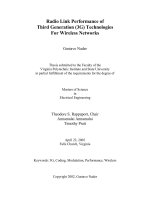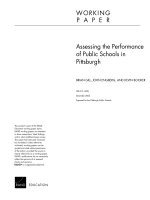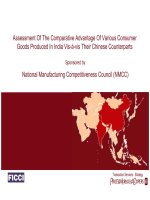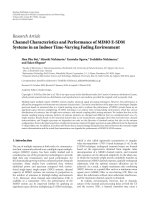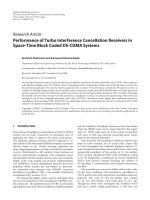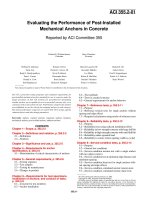Performance of various photovoltaic module technologies in tropical climate conditions
Bạn đang xem bản rút gọn của tài liệu. Xem và tải ngay bản đầy đủ của tài liệu tại đây (6.66 MB, 164 trang )
PERFORMANCE OF VARIOUS PHOTOVOLTAIC
MODULE TECHNOLOGIES IN TROPICAL
CLIMATE CONDITIONS
YE Jiaying
B.Sc. (Microelectronics), Sun Yat-Sen University
NATIONAL UNIVERSITY OF SINGAPORE
2014
PERFORMANCE OF VARIOUS PHOTOVOLTAIC
MODULE TECHNOLOGIES IN TROPICAL
CLIMATE CONDITIONS
YE Jiaying
A THESIS SUBMITTED
FOR THE DEGREE OF DOCTOR OF PHILSOPHY
NUS GRADUATE SCHOOL FOR INTEGRATIVE
SCIENCES AND ENGINEERING
NATIONAL UNIVERSITY OF SINGAPORE
2014
i
DECLARATION
I hereby declare that the thesis is my original work and it has been
written by me in its entirety. I have duly acknowledged all the sources of
information which have been used in the thesis.
This thesis has also not been submitted for any degree in any university
previously.
YE Jiaying
12 December 2014
ii
ACKNOWLEDGEMENTS
I would like to take this opportunity to express my deep gratitude to all the
people who have been supporting me during my PhD study.
I would like to firstly thank my supervisors - Prof. Armin Aberle, Dr.
Thomas Reindl and Dr. Timothy Walsh - for their continuous support and
guidance during my PhD study at the Solar Energy Research Institute of
Singapore (SERIS). I would also like to thank Prof. Joachim Luther for his
supervision during the first two years of my study. I thank Prof. Aberle and Dr.
Reindl for the invaluable feedback on my research progress and journal
publications. I personally thank Dr. Tim Walsh for his daily supervision and
continuous encouragement. Tim is recognized as a great mentor and friend. He
cares about the progress and needs of students and helped me overcome my
doubts and keep going. I thank my Thesis Advisory Committee chairperson
Prof. Charanjit Singh Bhatia and member Prof. Andrew A.O. Tay for their
invaluable time and feedback during our meetings.
I would like to thank the PVMD group mates: Khoo Yong Sheng, Jai
Prakash Singh, Chai Jing for the scientific discussions, and fun activities on
weekends; the PVMT group colleagues for the module testing; the SES group
mates for the help with experiments. I would also like to thank Dr. Rolf Stangl
and Miss. Guo Siyu for the very helpful discussions and cooperation, resulting
in a well-received journal publication.
The PhD marathon would be joyless without my friends in SERIS: Wang
Juan, Qiu Zixuan, Lu Fei, Ge Jia, and other office mates. Thank you for the
pleasant study atmosphere and all the joyful memories.
iii
I am truly grateful for the scholarship from the NUS Graduate School for
Integrative Sciences and Engineering.
Finally, the nonstop love and support of my parents have kept me positive
and strong. Thank you for being with me when I was happy or frustrated. I
would also like to thank my boyfriend, Mr. Manuel Danner and my best
friends in Singapore, Miss Huang Wenwen and Miss Zhang Mei, for their
warm company.
iv
Table of Contents
Table of Contents iv
Table of figures ix
Nomenclature xiv
Chapter 1 Introduction 1
1.1 Motivation 1
1.2 Background and review 3
1.2.1 Current status of PV module technologies 3
1.2.2 Characteristics of various PV module technologies 5
1.2.2.1 Crystalline Si 5
1.2.2.2 High-efficiency crystalline Si 6
1.2.2.3 Amorphous Si 6
1.2.2.4 Multi-junction Si 8
1.2.2.5 Cadmium telluride (CdTe) 8
1.2.2.6 Copper indium gallium diselenide (CIGS) 9
1.2.3 PV module power rating and outdoor performance indicator 10
1.2.3.1 Standard test conditions (STC) 10
1.2.3.2 Performance Ratio (PR) 10
1.2.4 Environmental factors affecting the module performance 12
1.2.4.1 Irradiance 12
1.2.4.2 Module temperature 13
1.2.4.3 Spectrum 14
1.2.4.4 Incident angle 16
1.3 Considerations for PV modules operating in the tropics 16
1.4 Thesis aims and objectives 19
1.5 Thesis outline 20
v
Chapter 2 Study of the spectral response of full-sized PV modules 23
2.1 Simulation 23
2.1.1 Methodology 23
2.1.2 Results 27
2.1.2.1 Idealized case: module with infinite shunt resistances 27
2.1.2.2 Influence of shunt resistances 28
2.1.3 Summary of the simulation results 34
2.2 Experimental measurement 34
2.2.1 Full-area illumination method to determine the spectral response
of PV modules 35
2.2.2 Test modules 36
2.2.3 Experimental setup 37
2.2.3.1 Illumination intensity (time dependence) 39
2.2.3.2 Spectral distribution 40
2.2.4 Uncertainty calculations 42
2.2.4.1 Electrical uncertainty 43
2.2.4.2 Temperature uncertainty 44
2.2.4.3 Optical uncertainty 44
2.2.4.4 Total uncertainty of the full-area measurement method 47
2.2.4.5 Results and discussion 47
2.3 Application of spectral response 49
2.3.1 Spectral mismatch 49
2.3.2 Spectral mismatch correction to AM1.5G for solar simulators . 51
2.4 Conclusions 52
Chapter 3 Influence of irradiance spectrum on module performance in the
tropics 53
3.1 Effect of solar spectrum on module performance 53
3.1.1 Effective
vi
3.1.1.1 Spectral mismatch factor calculated from measured SR 55
3.1.1.2 Spectral mismatch from measured short-circuit current 57
3.2 Setup for outdoor monitoring of PV modules 59
3.3 Results 61
3.4 Conclusion 68
Chapter 4 Influence of irradiance intensity on module performance in the
tropics 69
4.1 Fast-changing irradiance conditions 69
4.2 PV module performance under fast-changing irradiance 74
4.3 Conclusion 81
Chapter 5 Influence of temperature on PV module performance in the
tropics 83
5.1 Temperature coefficient 83
5.2 Operating temperatures of PV modules in Singapore 94
5.3 Thermal loss of PV modules working in the tropics 98
5.4 Conclusions 99
Chapter 6 Long-term outdoor performance of PV modules in tropical
Singapore 101
6.1 Methodology 101
6.2 Data for the study 104
6.3 Degradation 105
6.3.1 Degra
6.3.1.1 Performance ratio (PR) 106
6.3.1.2 Analysis of the degradation of individual components 107
6.4 Seasonality 115
6.5 Conclusion 117
Chapter 7 Tropical test conditions (TTC) 119
7.1 Defining the new tropical test conditions (TTC) 120
vii
7.2 TTC-based performance ratio (PR) 124
7.3 Conclusions 127
Chapter 8 Summary 128
8.1 Main contributions 128
8.2 Recommended future work: 131
Appendix 1: Publications arising from this work 132
Appendix 2: TTC spectrum 133
References 136
viii
Summary
While tropical climate zones are gaining momentum in the global
photovoltaic (PV) market, very little scientific work has been carried out on
the performance of PV modules under such climatic conditions. This PhD
thesis compares and analyses the performance of various PV modules (several
thin-film technologies as well as several crystalline silicon wafer based
technologies) in the tropics by conducting comprehensive indoor measure-
responses is performed, revealing that the blue-shifted spectrum in the tropics
causes significant differences in the module performance. Based on outdoor
testing data, a model is derived to extract the temperature coefficients of the
irradiance and module temperature. Module degradation rates are found to be
relatively high compared to temperate clim
across different PV module technologies in tropical regions.
ix
Table of figures
Figure 1.1: Historic and expected development of the global solar PV market
[3]. 1
Figure 1.2: Production capacities of thin-film PV module for CdTe, a--Si
and CIGS [14]. 4
Figure 2.1: Sketch of a typical silicon wafer-based c-Si module as used in the
simulation. 24
Figure 2.2: Sketch of the circuit simulation model of a silicon wafer-based PV
module based on the one-diode model. 25
Figure 2.3: Simulated SR of a 60-cell PV module with (red dashed line) and
without (black solid line) bypass diodes. Each cell has an infinite shunt
resistance, but a slightly different SR. The SR curves of all individual cells fall
into the grey band 28
Figure 2.4: I-
2
2
(red dashed) under (a) 1
sun condition (AM1.5G solar irradiance) and (b) monochromatic illumination
(400 nm light with an intensity of 50 W/ m
2
). 29
Figure 2.5: Simulated module SR of a silicon wafer-based module with (red
dashed line) and without (black solid line) bypass diodes, consisting of 60
cells as sketched in Figure 2.1, exhibiting a slightly different SR. (a) Each cell
2
; (b) each cell has a low shunt
2
; (c) 59 cells have a low shunt resistance of 1.7
2
, and 1 cell has a high sh
2
and this one cell
having a low SR in the wavelengths of 500 nm to 1000 nm; and (d) this one
cell having a high SR in the wavelengths of 500 nm to 1000 nm. The SR
curves of all individual cells are shown in grey. 30
Figure 2.6: Current-voltage curves of two crystalline Si solar cells with
different short-circuit currents due to different SR and (a) the same high shunt
resistances; (b) the same low shunt resistances; (c) the cell with the low SR
having a high shunt resistance and the cell with the high SR having a low
shunt resistance; and (d) the cell with the low SR having a low shunt
resistance and the cell with the high SR having a high shunt resistance. The
x
corresponding operating points when the two cells are connected in series are
indicated as blue points. 31
Figure 2.7: I-V curves of two strings, each with 20 silicon wafer-based cells
connected in series, having different photocurrents. The red curve is the I-V
curve of the string with the higher photocurrent, and the black curve is the one
with the lower photocurrent. Blue points are the operating points when the two
strings are connected in series (a) without bypass diodes and (b) with bypass
diode (the I-V curve of the bypass diode is sketched as blue solid line). 33
Figure 2.8: Setup for I-V curve and SR measurement. 38
Figure 2.9: Short-circuit current vs. irradiance intensity of studied modules. . 39
Figure 2.10: Irradiance of one large-area pulse versus time. During the data
acquisition time (10 ms), the irradiance varies by less than ± 1%. 40
Figure 2.11: Spectral characteristics of the light source of the solar simulator
(with and without quasi-monochromatic filters). The global AM1.5 spectrum
is also shown for comparison. 41
Figure 2.12: Integrated irradiance passing through the filters. The black bars
represent the measured irradiance from the solar simulator using the actual
filters. The red bars represent the ideal case (AM1.5G spectral irradiance with
ideal rectangular on/off filters with 50 nm bandwidth). 42
Figure 2.13: Measured spatial irradiance uniformity over the module testing
area for all 15 filters. The whiskers denote the 10% and 90% values of the
deviation. The 25% and 75% values are used as the bottom and top edges in
the box charts, and the lines inside the boxes denote the median. 45
Figure 2.14: Absolute SR measurements of the five modules measured at
SERIS with full-area illumination, together with the calibrated SR curve of the
used c-Si reference solar cell. The error-bars were calculated as described in
the previous sections. 48
Figure 3.1: Measured relative SRs of the investigated single-junction PV
module technologies (single-junction a-Si, CdTe and CIGS). Data before 400
nm and after 1100 nm are obtained with extrapolation. The SR curves for the
top and bottom cells of the investigated double-junction micromorph Si
technologies (dashed lines) are taken from the literature [184]. Also shown,
for comparison, is the SR of a multicrystalline Si sensor. 55
Figure 3.2: Outdoor PV module performance testing system at NUS. 60
xi
Figure 3.3: Monthly effective irradiance ratios of the investigated thin-film PV
modules based on the spectral mismatch factor (
) (solid lines) and the
short-circuit current (
) (short-dash lines). The
for the single-
junction a-Si module in June was calculated based on data from 1
st
June to 10
th
June. The
for the double-junction micromorph module is missing
because the SR of this module was not available. 63
Figure 3.4: Solar noon spectra for a hazy day and an averaged day in
Singapore in 2013. The grey line shows the AM1.5G spectrum. 64
Figure 3.5: In-plane (G
i
), diffuse irradiance (G
d
) and average photon energy
(APE) of the outdoor spectrum for an averaged day in Singapore. An averaged
day is obtained by averaging the 1-year results into a single day. The APE of
the standard AM1.5G spectrum from 305 to 1150 nm (1.83 eV) is also shown
for comparison. 66
Figure 3.6: Averaged day effective irradiance ratio based on the MMF
(
) (solid lines) and the
(short-dash lines) for the thin-film
PV modules studied on an averaged day in Singapore. 67
Figure 4.1: Measured irradiance on a typical day in Singapore (03-Apr-2011)
characterised by a high level of variability (in black), compared with simulated
clear-sky irradiance (in blue) and the 2011 averaged day irradiance (in red)
[194]. 70
Figure 4.2: Comparison of simulated irradiance with measured irradiance
during an exceptional day with clear-sky conditions in Singapore (05-Aug-
2011). 72
Figure 4.3: Radiation energy distribution with respect to irradiance level and
time range of variability in Singapore (2011 data). 74
Figure 4.4: Box charts of relative
of selected PV modules: (a)
monocrystalline Si; (b) micromorph Si; (c) a-Si single junction; (d) a-Si
(high irradiance)
according to irradiance levels lower and higher than the 69% of the modelled
clear-sky irradiance. 76
Figure 4.5: Measured spectra at various irradiance levels on 17
th
October 2011,
normalised with the AM1.5G reference spectrum. 77
xii
Figure 4.6: Mono c-Si module temperature vs. duration of the stable irradiance,
for low and high irradiance levels. 79
Figure 4.7: Average annual efficiencies of the four investigated PV module
technologies versus the increasing duration (in minutes) of stable irradiance,
for low-irradiance and high-irradiance conditions. Lines are guides for the eye.
The value at 2 min shows the readings for < 2 min; the value of 5 min shows
the readings for 2 - 5 min, etc. 81
Figure 5.1: Temperature of the two studied modules and irradiance on the
averaged day of 2011 in Singapore. 90
Figure 5.2: Temperature coefficient as a function of irradiance and module
temperature for the module with (a): standard glass-backsheet construction
and (b): glass-glass construction on the 2011 averaged day. The blue plane
shows the datasheet value of . 91
Figure 5.3: Projection of Figure 5.2 on y-z and x-z planes for the module with
(a) standard glass-backsheet construction and (b) glass-glass construction. 91
Figure 5.4: Module temperatures of the two modules vs irradiance for different
times of the day. 92
Figure 5.5: Average ambient temperature comparison between Singapore and
Frankfurt. [234] 94
Figure 5.6: Dependence of module temperature above ambient temperature on
irradiance intensity for the 10 modules in this study. The module type
corresponding to each number is listed in Table 5.1. 97
Figure 5.7: Distribution of module temperatures (monocrystalline Si module
with standard glass-backsheet construction) over a 1-year period from 1-Jan-
2013 till 31-Dec-2013. Data with irradiance below 20 W/m
2
was filtered out to
exclude night time conditions. 98
Figure 5.8: Thermal loss of the 10 PV modules, calculated based on the
temperature coefficient from datasheet. 99
Figure 6.1: The decomposition of monthly performance ratio (PR) for the
double-junction micromorph Si module from 01-Jan-2011 till 31-Dec-2013.
104
Figure 6.2: Measured monthly performance ratios (PR) of the 10 module types
under investigation in this study. 106
xiii
Figure 6.3: The decomposed trend of performance ratios (PR) of the 10
module types under investigation in this study. 107
Figure 6.4: Decomposed trend of short-circuit current (I
SC
), open-circuit
voltage (V
OC
), and fill factor of the 10 modules under investigation in this
study. 108
Figure 6.5: Average annual degradation rate (%) of performance ratio (PR)
and the I-V curve components: short-circuit current (I
SC
), open-circuit voltage
(V
OC
), fill factor (FF) for the 10 module types under investigation in this study.
109
Figure 6.6: I-V curves of the 10 module types under investigation in this study
on 01-Jan-2011 and 01-Jan-2013, at around 11:30 with irradiance of 900 ± 10
W/m
2
(stable for > 2 min). 111
Figure 6.7: Decomposed seasonality of different PV technologies from 1-Jan-
2011 to 31-Dec-2013. 116
Figure 6.8: Variation of air mass in Singapore at solar noon over a year [183].
117
Figure 7.1: DC performance ratio (PR) based on STC power for individual
modules. Data from 01-Jan-2013 till 31-Dec-2013 were used for the
calculation. 119
Figure 7.2: Distribution of radiation energy with respect to irradiance level
over year 2013 121
Figure 7.3: Histogram of APE for all irradiance levels over the whole year of
2013 122
Figure 7.4: Histogram of APE with irradiance within the 700 - 900 W/m
2
range. 122
Figure 7.5: Histogram of module temperature over a one-year period from 01-
Jan-2013 to 31-Dec-2013, with irradiances between 700 and 900 W/m
2
124
Figure 7.6: Performance ratio (PR) based on newly defined Tropical Test
Conditions (TTC), as proposed in this work. 126
xiv
Nomenclature
Pmpp Maximum power output (W)
P
0
Nameplate maximum power output (W)
Vmpp Voltage at maximum power point (V)
Impp Current at maximum power point (A)
R
S
Series resistance (Ohm)
R
Shunt
Shunt resistance (Ohm)
Power output at standard test conditions (W)
Open-circuit voltage at standard test conditions (V)
Short-circuit current at standard test conditions (A)
Short-circuit current (A)
Open-circuit voltage (V)
Relative temperature coefficient of the short-circuit current (%/°C)
Relative temperature coefficient of the open-circuit voltage (%/°C)
Relative temperature coefficient of the maximum power (%/°C)
T
mod
Temperature of a PV module, measured at the backsheet (°C)
In-plane irradiance (W/m
2
)
Irradiance at standard test conditions (1000 W/m
2
)
Effective irradiance after spectral correction (W/m
2
)
Z
Solar zenith angle (degree)
Solar incident angle of a tilted surface (degree)
E Energy produced by a PV module in a given time period (Wh)
E
i
In-plane solar radiation in a given time period (Wh)
STC Standard test conditions
1
Chapter 1 Introduction
1.1 Motivation
As the demand of electric energy consumption keeps rising with the
ever-growing population, one of the key challenges facing humanity in the
long run will be to generate electricity in a carbon-neutral and sustainable way.
Among the different renewable energies, solar energy is by far the most
abundant and available virtually everywhere [1]. The effect of generation of
voltage or electric current in a material upon exposure to light is called
photovoltaics (PV) [2]. The application of PV modules has seen a massive
growth since the 2000s, thanks to the introduction of feed-in tariffs,
predominantly in Europe. This development is expected to continue at a
smaller growth rate, however now from a higher level (see Figure 1.1).
Figure 1.1: Historic and expected development of the global solar PV market [3].
2
Based on a fast and continuous economic development, the Asia Pacific
region is predicted to account for more than half of
consumption by 2035, according to a study by the Asian Development Bank
[4]. The high demand of energy has raised social, political, and economic
challenges, which call for sustainable solutions. Renewable energy has thus
been given more attention and grown continuously in this region.
The Asian tropical sunbelt, with about 50 per cent more annual solar
radiation than temperate regions like Japan or Germany [4], makes it more
appropriate for solar applications. The market size for PV in south-east Asia is
expected to reach 20 GW by 2017 [5]. Presently, Thailand, Malaysia and
Indonesia are driving the south-east Asian PV market. Thailand has accounted
for the majority of installations in the region and became the fifth largest
market in Asia in 2012 (after China, Japan, India and Australia). Malaysia has
aimed for 55 MW of PV system installations by the end of 2015 [6], and
Indonesia also plans to install solar systems for thousands of more households
in rural eastern Indonesia [7]. The Singapore government has invested large
efforts into PV development and realization. Given the rapid decreases in the
cost of solar panels in the past several years, solar electricity has become cost-
competitive with traditional energy from the grid in Singapore, reaching the
so-grid parity in 2012 for larger roof-top systems [8]. The Singapore
government has an ambitious target of 80% green buildings by 2030, and is
pioneering various solar projects on the island [9]. It is expected that the PV
system market in South-East Asia will grow continuously and substantially in
the coming years. However, the environmental conditions in the tropics
(constantly high ambient temperature, high humidity, and fast-changing
3
irradiance) are very different from those in temperate climates, under which
PV module performance is widely reported. The performance and reliability of
PV modules depends on the operating conditions. It is therefore important to
fill the knowledge gap on PV module performance in the tropics. This
information can provide constructive advice to manufacturers to produce PV
modules optimized for the tropical climates and is also desirable for system
integrators and investors to easily determine which type of PV module techno-
logy gives the best performance at the given conditions in the tropics.
1.2 Background and review
1.2.1 Current status of PV module technologies
Solar PV module production is set to reach 49 gigawatts (GW) in 2014 [10].
Among all the technologies in the PV market, wafer-based crystalline silicon
("c-Si") is so far the most developed material for PV cells and modules, and
huge achievements have been reached in improving its costs and conversion
efficiencies [11]. The market share of monocrystalline silicon (mono c-Si) and
multicrystalline silicon (multi c-Si) together was over 90% at the end of 2013
[12]. The multicrystalline Si technology itself accounts for 62% of all modules
produced. Although thin-film modules comprise less than 10% of the global
PV market, the production keeps growing due to the overall growth of the
industry. The major materials for thin-film PV modules are (1) amorphous
silicon ("a-Si"), (2) microcrystalline silicon ("c-Si"), (3) Cadmium telluride
("CdTe"), and (4) Copper indium gallium diselenide ("CIGS") [13]. Figure 1.2
shows the expected production capacities of thin-film materials until 2015 [14].
4
Figure 1.2: Production capacities of thin-film PV module for CdTe, a--Si and CIGS [14].
The much lower share of thin-film modules is mainly due to their lower
efficiencies compared to c-Si modules at comparable prices [15]. While c-Si
modules have an average efficiency between 13% to 20%, thin-film modules
are only between 7% to 16% [16]. It was believed that thin-film technologies
generically have the potential of lower manufacturing cost due to less material
usage and standardised, high-throughput machines [17]. However, due to a
current over-capacity in the c-Si PV industry and the availability of low-cost
silicon feedstock, prices for c-Si modules have fallen constantly over the past
few years to below 0.7 EURO/W
p
today, which is comparable to that of thin-
film modules (0.6 EURO/W
p
)
[18]. Thin-film technologies have the advantage
to be deposited at low temperatures, which enables the photo-active layers to
be deposited onto a number of materials including glass, plastic, metal as well
as flexible substrates [1, 19]. In addition, the room for efficiency improvement
is large and the world records for CIGS and CdTe modules are being broken
5
every few months [20, 21]. Since the aim of this study is to provide advice on
how different PV module technologies perform under tropical climates, this
work will thus focus on the module technologies available on the market,
including crystalline Si, amorphous Si, micromorph Si, CdTe, and CIGS
modules. Based on the findings, suggestions to industrial production are also
proposed for optimized module performance in the tropics. The characteristics
of each technology and the influence of environmental factors to the module
performance are reviewed in the following part of this chapter.
1.2.2 Characteristics of various PV module technologies
1.2.2.1 Crystalline Si
Crystalline Si refers to both monocrystalline Si (mono c-Si) and multi-
crystalline Si (multi c-Si), depending on the presence of grain boundaries in
the Si. Monocrystalline Si is also often -
produced using the Czochralski process, which requires high temperatures
(~1500°C) and long process times to grow single-crystal ingots [22]. Multi
c-Si is produced in a simpler and faster way, including the melting and cooling
of silicon [23]. The grain sizes of the resulting multi c-Si can range from
millimetres to centimetres, depending on the temperature control of the
process [24]. Since mono c-Si solar cells do not have grain boundaries which
introduce discontinuities in the silicon and deteriorate the local electronic
properties, their conversion efficiency is higher than multi c-Si solar cells if
the same cell structure is used. The present average prices for a 156-mm mono
c-Si solar cell and a 156-mm multi c-Si solar cell are around $2.7 and $2.2,
respectively [25]. The efficiency gap of about 1-2 % (absolute) between mono
c-Si solar cells and multi c-Si solar cells has remained stable over the years
6
[26]. The rated module efficiencies of conventional crystalline Si modules are
about 13% to 16% [27-29]. The warranty for crystalline Si modules usually
covers 25 years. The performance of c-Si modules is generally stable and the
performance degradation rate is relatively low, usually less than -1%/year [30].
1.2.2.2 High-efficiency crystalline Si
Various approaches have been devised to enhance the conversion efficiency
of c-Si solar cells. To improve the c-Si cell efficiency, high-carrier-lifetime
substrates are usually required, in combination with extra processing and
sophisticated structures, such as laser grooved buried contacts (LGBC),
emitter wrap through (EWT), all back contact (ABC), and heterojunction with
intrinsic thin layer (HIT) cells [31-35]. The first three technologies enhance
the cell efficiency through the reduction of shading losses caused by the front
metal contacts. HIT is a technology using the excellent surface passivation
properties of a-Si on c-Si to improve the cell conversion efficiency. Module
efficiencies beyond 20% have been commercialized with these novel solar cell
technologies [36]. But these high-efficiency modules usually have a higher
manufacturing cost due to the numerous and complicated fabrication processes.
1.2.2.3 Amorphous Si
Amorphous Si (a-Si) PV modules have been in commercial production
since 1980 [37]. The production of a-Si requires only about 1% of the silicon
that would have been used to produce a c-Si based solar cell, so in theory they
should be much cheaper than c-Si based solar cells [38]. However, the
conversion efficiency of a-Si modules is about 6 to 8 % (absolute) lower than
that of c-Si modules, and thus one would have to cover a larger surface with
7
a-Si solar panels compared to crystalline-based solar panels for an equal
output of electrical power. The low space-efficiency also means that the costs
of space and support structures will increase.
The amorphous structure results in high defect density and low doping
efficiency. Hydrogen is thus used to passivize the defects and enhance doping
efficiency for a-Si module production [39]. Some weak Si-H bonds are broken
due to light soaking and dangling bonds are generated, which causes signifi-
cant reduction in efficiency during the initial implementation [40, 41]. The
number of dangling bonds reaches equilibrium after prolonged illumination so
that further photodegradation is limited. The efficiency reduction can be up to
30% in the first several months [42], and the wide-range variation in power
and voltage causes additional difficulty in sizing the inverter because inverters
can work with high efficiency only in certain voltage ranges [43]. Even after
this initial degradation, a combination of the light-induced degradation (also
called Staebler-Wronski effect) [44] and annealing effect, which reverses the
photodegradation effects [45], continue to cause seasonal variations in the
efficiency of a-Si PV modules. These changes in efficiency are driven by the
and the temperature of operation [46]. The density of these so-called light-
induced defects can be decreased by annealing at temperatures above a
hundred degrees Celsius [47], while in real-life operation, the annealing effect
causes a-Si modules to perform relatively better in summer than in winter in
temperate regions [48]. The nameplate power of a-Si modules are usually
stated as the stabilized power, which is under-rated to accommodate for the
degradation effects.
8
1.2.2.4 Multi-junction Si
Since the efficiency of solar cells based on single-junction a-Si is too low to
be competitive for power applications, tandem-cell technologies were
developed to better utilize the solar spectrum and thereby boost the PV
efficiency [49]. Adding germanium (Ge) to the silicon can reduce the bandgap
of the amorphous material, thus enabling the double- ('tandem') or triple-
junction (e.g., a-Si/a-Si/a-SiGe) solar cells. One company, United Solar
Ovonic, was commercially making such triple-junction modules [50], but it
went bankrupt in 2012. Amorphous Si cells can also be combined with another
silicon based material such as nano- or microcrystalline silicon (nc-Si or c-Si)
to form a tandem solar cell [51]. Such technology is usually referred to as
Sharp and Kaneka are presently the two main companies
producing multi-junction Si modules. Multi-junction cells are interconnected
in series, and the current of the two stacked cells is usually optimized for the
standard Air Mass 1.5 global (AM1.5G) spectrum.
1.2.2.5 Cadmium telluride (CdTe)
The world-record efficiency for CdTe solar cells and modules to date are
19.6% and 16.1%, respectively [15], held by First Solar, the most successful
company producing commercial CdTe modules. CdTe is, in principle, one of
the best-suited materials for photovoltaics with its direct bandgap of 1.44 eV,
close to the optimum for solar conversion [14]. There are, however, environ-
mental issues with products that rely on cadmium a heavy metal and
potential carcinogen that can accumulate in plant and animal tissues [52].
While the threat is minimal so long as the compound is contained within the
solar panel [53], the safety is still an issue in case of fire accidents. In addition,
9
the disposal and recycling remains a concern [54]. Compared to a-Si, CdTe
exhibits relatively better stability, but it is also reported to show light-induced
metastabilities after extended light soaking (more than 5000 hours) [55, 56].
1.2.2.6 Copper indium gallium diselenide (CIGS)
In 2013, a CIGS solar cell with a new record efficiency of 20.4% was
achieved on flexible polymer foils [20]. This makes CIGS-based solar panels
the highest performing thin-film solar panels to date. The commercial CIGS
modules sold today usually have efficiencies in the range of 10 to 14 % [57-
59]. Although CdS is used as an n-type window layer (as in CdTe modules),
much less of the toxic material cadmium is present in CIGS solar cells
compared to CdTe solar cells. There are now also Cd-free CIGS modules
commercially available [60]. CIGS solar cells are reported to exhibit
pronounced metastabilities and performance variation with light exposure [61,
62]. If the devices are stored for a long time in in the dark, the fill factor and
V
OC
are considerably smaller (especially at elevated cell temperatures) than
would otherwise be the case [63]. The quasi-stable properties of CIS or CIGS
modules are still not clearly identified, and the light soaking effects vary
greatly depending on the device structure and especially the buffer layer
composition [64, 65]. Some module types were reported to be very sensitive to
illumination and even an exposure to light for less than a second can vary the
material states, whereas others show better stability [66, 67]. Despite the high
sensitivity, it has been verified that the flash test (with a sweep time of less
than1 second) itself does not cause significant light-induced effects to CIGS
modules [68].
